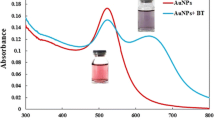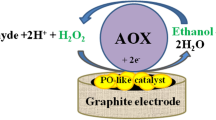Abstract
In pH 8.4 Tris–HCl buffer solutions, alcohol dehydrogenase catalyzed the reaction between ethanol and nicotinamide adenine dinucleotide to produce acetaldehyde. In the medium of HCl, acetaldehyde reduced HAuCl4 to form gold particles that exhibited a strong resonance scattering (RS) peak at 600 nm. The RS peak increased with ethanol concentration. The increased RS intensity at 600 nm (ΔI 600 nm) was proportional to the ethanol concentration (C) from 0.068 to 10.2 mmol/L, with a regression equation of ΔI 600 nm = 35.59 C + 16.1, and a detection limit (3σ) of 3.2 μmol/L. This proposed method was applied to detect ethanol in saliva and plant cell culture medium samples, with satisfactory results.






Similar content being viewed by others
References
Thongchul N, Navankasattusas S, Yang ST (2010) Production of lactic acid and ethanol by Rhizopus oryzae integrated with cassava pulp hydrolysis. Bioprocess Biosyst Eng 33:407–416
Kim I, Han OH, Chae SA, Paik Y, Kwon SH, Lee KS, Sung YE, Kim HS (2011) Catalytic reactions in direct ethanol fuel cells. Angew Chem Int Ed 50:2270–2274
Atsushi H, Atsushi Y, Mikihito K, Ni K, Takaharu K (2005) Simple and rapid determination of metabolite content in plant cell culture medium using an FT-IR/ATR method. Bioprocess Biosyst Eng 27:115–123
Tangerman A (1997) Highly sensitive gas chromatographic analysis of ethanol in whole blood, serum, urine, and fecal supernatants by the direct injection method. Clin Chem 43:1003–1009
Yarita T, Nakajima R, Otsuka S (2002) Determination of ethanol in alcoholic beverages by high-performance liquid chromatography-flameionization detection using pure water as mobile phase. J Chromatograph A 976:387–391
Bernero M, Bare RE, Haith CE, Grossman MJ (2004) Detection of alkanes, alcohols, and aldehydes using bioluminescence. Biotechnol Bioeng 87:170–177
Deng L, Zhang LH, Shang L, Guo SJ, Wen D, Wang FA, Dong SJ (2009) Electrochemiluminescence detection of NADH and ethanol based on partial sulfonation of sol–gel network with gold nanoparticles. Biosens Bioelectron 24:2273–2276
Ye Q, Xu QF, Yu YA, Qu RH, Fang ZJ (2009) Rapid and quantitative detection of ethanol proportion in ethanol–gasoline mixtures by Raman spectroscopy. Opt Commun 282:3785–3788
Rangel AOSS, Toth IV (2000) Enzymatic determination of ethanol and glycerol by flow injection parallel multi-site detection. Anal Chim Acta 416:205–210
Lee CA, Tsai YC (2009) Preparation of multiwalled carbon nanotube-chitosan-alcohol dehydrogenase nanobiocomposite for amperometric detection of ethanol. Sens Actuators B 138:518–523
Gallignani M, Ayala C, Brunetto MR, Burguera JL, Burguera M (2005) A simple strategy for determining ethanol in all types of alcoholic beverages based on its on-line liquid–liquid extraction with chloroform, using a flow injection system and Fourier transform infrared spectrometric detection in the mid-IR. Talanta 68:470–479
Garrigues JM, Perez-Ponce A, Garrigues S (1997) Direct determination of ethanol in liquid samples by means of vapor phase–fourier ransform infrared spectrometry. Vib Spectrosc 15:219–281
Pinalli R, Nachtigall FF, Ugozzoli F, Dalcanale E (1999) Supramolecular sensors for the detection of alcohols. Angew Chem Int Ed 38:2377–2380
Shkotova LV, Soldatkin AP, Gonchar MV, SchuhmannW DSV (2006) Amperometric biosensor for ethanol detection based on alcohol oxidase immobilised within electrochemically deposited Resydrol film. Mater Sci Eng: C 26:411–414
Ajay AK, Srivastava ND (2007) Microtubular conductometric biosensor for ethanol detection. Biosens Bioelectron 23:281–284
Liu WH, Yang W, Wu XQ, Lin ZX (2007) Direct determination of ethanol by laser Raman spectra with internal standard method. Chin J Anal Chem 35:416–418
Pasternack RF, Collings P (1995) Resonance light scattering: a new technique for studying chromosphere aggregation. Science 269:935–939
Luo HQ, Li NB, Liu SP (2006) Resonance rayleigh scattering study of interaction of hyaluronic acid with ethyl violet dye and its analytical application. Biosens Bioelectron 21:1186–1194
Du BA, Li ZP, Liu CH (2006) One-step homogeneous detection of DNA hybridization with gold nanoparticle probes by using a linear light-scattering technique. Angew Chem Int Ed 45:8022–8025
Jiang ZL, Sun SJ, Liang AH, Huang WX, Qin AM (2006) Gold-labeled nanoparticle-based immunoresonance scattering spectral assay for trace apolipoprotein AI and apolipoprotein B. Clin Chem 52:1389–1394
Liang AH, Zhang NN, Jiang ZL, Wang SM (2008) A sensitive resonance scattering spectral assay for the determination of trace H2O2 based on the HRP catalytic reaction and nanogold aggregation. J Fluoresc 18:1035–1041
Jiang ZL, Fan YY, Chen ML, Liang AH, Liao XJ, Wen GQ, Shen XC, He XC, Pan HC, Jiang HS (2009) Resonance scattering spectral detection of trace Hg(II) using aptamer modified nanogold as probe and nanocatalyst. Anal Chem 81:5439–5445
Liang AH, Zhou LP, Qin HM, Zhang Y, Ouyang HX, Jiang ZL (2011) A highly sensitive aptamer-nanogold catalytic resonance scattering spectral assay for melamine. J Fluoresc 21:1907–1912
Jiang ZL, Li F, Li TS, Liang H (2000) The relationship between resonance scattering intensity and the size of Au particles. Chem J Chinese U 21:1488–1490
Wu LN, Zhang XJ, Ju HX (2007) Detection of NADH and ethanol based on catalytic activity of soluble carbon nanofiber with low overpotential. Anal Chem 79:453–458
Shi J, Ci PL, Wang F, Peng H, Yang PX, Wang LW, Wang QJ, Chu PK (2011) Pd/Ni/Si-microchannel-plate-based amperometric sensor for ethanol detection. Electrochim Acta 56:4197–4202
Acknowledgments
This work supported by the National Natural Science Foundation of China (nos. 20865002, 21075023, and 21165005) and the Natural Science Foundation of Guangxi (nos. 0832260 and 0991021Z).
Author information
Authors and Affiliations
Corresponding author
Rights and permissions
About this article
Cite this article
Luo, Y., Wang, P., Li, T. et al. A Highly Sensitive Enzyme Catalytic Method for the Detection of Ethanol Based on Resonance Scattering Effect of Gold Particles. Plasmonics 8, 307–312 (2013). https://doi.org/10.1007/s11468-012-9390-0
Received:
Accepted:
Published:
Issue Date:
DOI: https://doi.org/10.1007/s11468-012-9390-0




